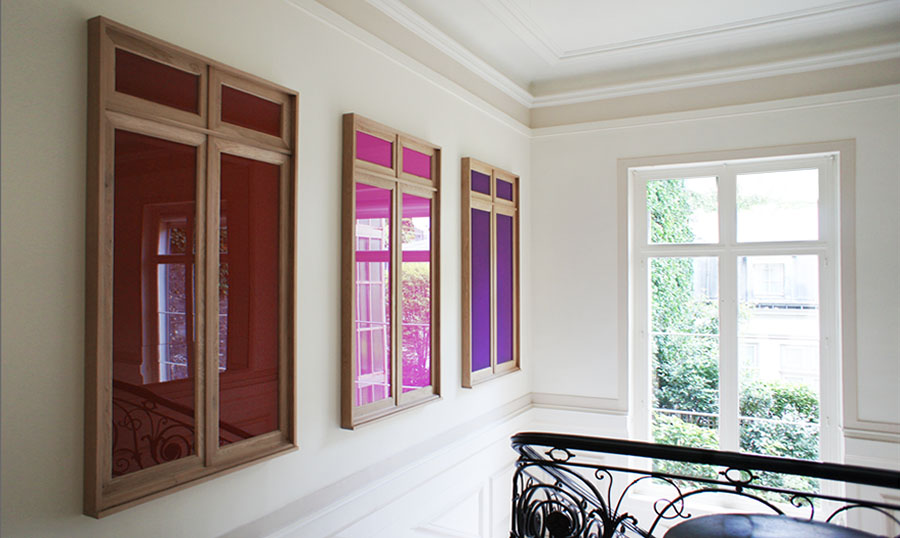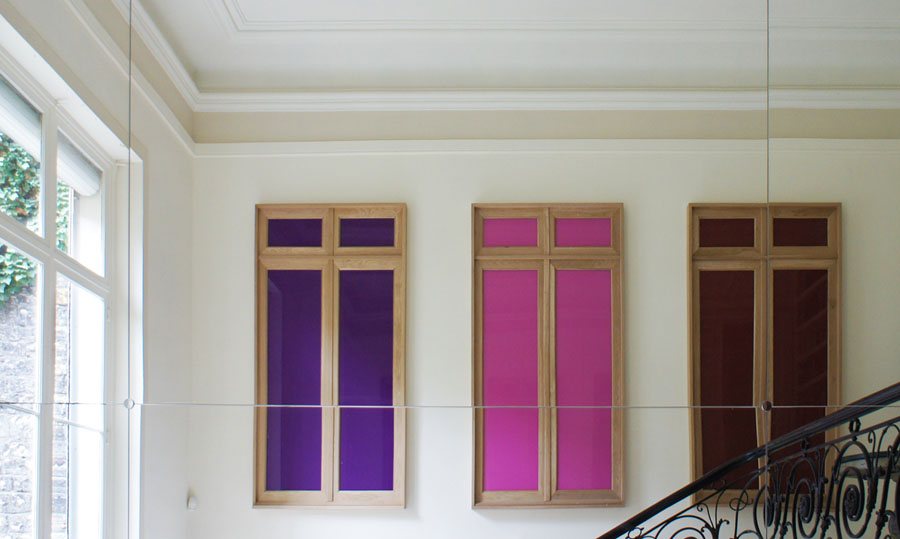infrared invisible ultraviolet
(d'après la bagarre d'austerlitz)
2010
collection privée, paris
verre laqué, chêne massif
240x130 cm chaque élément


.
Mon point de départ fut la grande fenêtre présente chez ce collectionneur et celle de Duchamp (la bagarre d’Austerlitz, réalisée en 1921, un an après Fresh Widow) et sa réflexion qui l’accompagne à propos de la fenêtre comme archétype de la peinture.
Ici c’est la face extérieure des fenêtres qui est présentée, de telle sorte que le regardeur ait le sentiment d’être lui aussi à l’extérieur, regardant à travers les fenêtres ce qui est à l’intérieur. Mais le regardeur est bien à l’intérieur, il regarde donc aussi à l’extérieur.
Les verres sont laqués, ils deviennent une surface dont l’épaisseur capte discrètement le reflet uniformisé de sa silhouette et de tout ce qui l’entoure (Marc Donnadieu en parlait comme d’un matériau horizon); il pourrait lui donner le sentiment d’être à l’intérieur d’un autre espace dont chaque fenêtre serait l’entrée possible.
La lumière visible est la partie du spectre électromagnétique qui est visible pour l’œil humain. L’ultraviolet et l’infrarouge sont considérés comme lumière (car de même nature électromagnétique que la lumière visible) mais ne sont pas visibles par l’oeil humain. Le spectre de la lumière visible s’étend du rouge au violet en passant en dégradé par l’orange, le jaune, le vert, cyan, bleu et l’indigo. Le magenta, ne correspondant à aucune radiation pure, n’en fait pas partie ; je l’ai envisagé comme la couleur de l’invisible.
Les couleurs des laques ont donné son titre à l’oeuvre : infrarouge, invisible, ultraviolet, un travail qui interroge simultanément les limites de notre perception, celle de notre connaissance du monde, des autres et de nous-mêmes.
My starting point was the large window I saw at this collector’s place as well as the one from Duchamp (la bagarre d’Austerlitz, created in 1921, one year after Fresh Widow) with his evolving thoughts about the window as an archetype of painting.
In this work, the windows are displayed by their external face, so that anyone who looks at them will have the feeling as well of being outside, looking inside through the windows. But they are indeed inside – also looking outside.
The glass is lacquered, it becomes a surface, the thickness of which discreetly captures the homogenous reflection of the onlookers’ silhouette and all that surrounds them (Marc Donnadieu refers to it as a ‘material-horizon’) ; it could give them the impression of being inside another space where every window could be a possible entrance.
The visible light is the part of the electromagnetic spectrum which is visible for the human eye. Ultraviolet and infrared are considered to be light (since they are both of the same electromagnetic nature as the visible light) but are not visible to the human eye. The spectrum of visible light ranges from red to purple, going through orange, yellow, green, cyan, blue and indigo. , Not being a pure radiation, magenta is not part of it ; I thought of it as the color of the invisible.
The name of this work stems from the colors of the lacquer : infrared, invisible, ultraviolet - a work that simultaneously questions the limits of our perception, of our knowledge of the world, of the other and of ourselves.